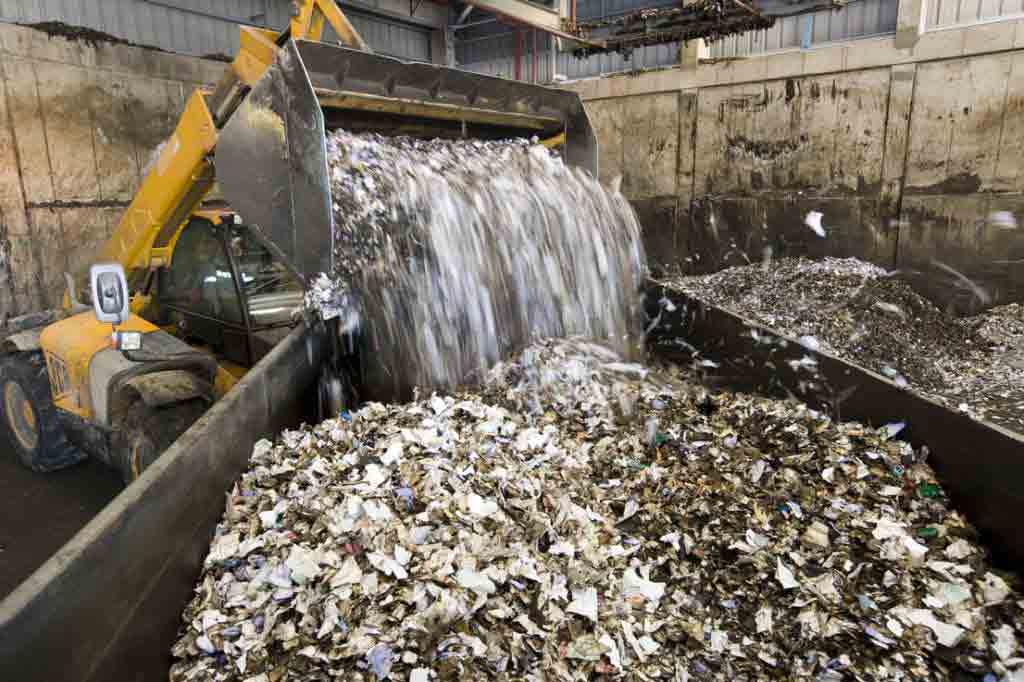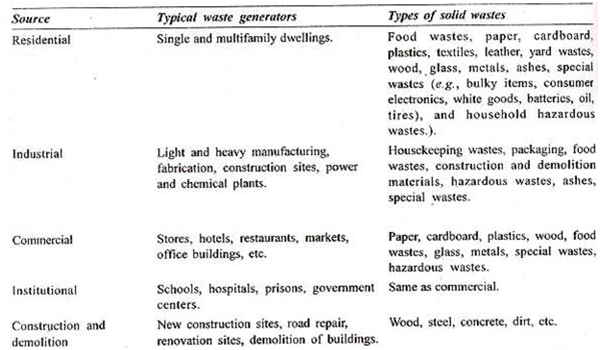soil waste management
Solid waste management is a polite term for garbage management. As long as liumans have been living in settled communities, solid waste, or garbage, has been an issue, and modern societies generate far more solid waste than early humans ever did.
Daily life in industrialized nations can generate several pounds of solid waste per consumer, not only directly in the home, but indirectly in factories that manufacture goods purchased by consumers.
Garbage: many broad categories of garbage are:
i. Organic waste: kitchen waste, vegetables, flowers, leaves, fruits.
ii. Toxic waste: old medicines, paints, chemicals, bulbs, spray cans, fertilizer and pesticide containers, batteries, shoe polish.
iii. Recyclable: paper, glass, metals, plastics.
iv. Hospital waste such as cloth with blood
1. Types & Source of Solid Wastes:
Basically solid waste can be classified into different types depending on their source:
2. Effects of Solid Waste Pollution:
Municipal solid wastes heap up on the roads due to improper disposal system. People clean their own houses and litter their immediate surroundings which affects the community including themselves.
This type of dumping allows biodegradable materials to decompose under uncontrolled and unhygienic conditions. This produces foul smell and breeds various types of insects and infectious organisms besides spoiling the aesthetics of the site. Industrial solid wastes are sources of toxic metals and hazardous wastes, which may spread on land and can cause changes in physicochemical and biological characteristics thereby affecting productivity of soils.
Toxic substances may leach or percolate to contaminate the ground water. In refuse mixing, the hazardous wastes are mixed with garbage and other combustible wastes. This makes segregation and disposal all the more difficult and risky.
Various types of wastes like cans, pesticides, cleaning solvents, batteries (zinc, lead or mercury), radioactive materials, plastics and e-waste are mixed up with paper, scraps and other non-toxic materials which could be recycled. Burning of some of these materials produces dioxins, furans and polychlorinated biphenyls, which have the potential to cause various types of ailments including cancer.
3. Methods of Solid Wastes Disposal:
i. Sanitary Landfill
ii. Incineration
iii. Composting
iv. Pyrolysis
i. Sanitary Land Filling:
In a sanitary landfill, garbage is spread out in thin layers, compacted and covered with clay or plastic foam. In the modern landfills the bottom is covered with an impermeable liner, usually several layers of clay, thick plastic and sand. The liner protects the ground water from being contaminated due to percolation of leachate.
Leachate from bottom is pumped and sent for treatment. When landfill is full it is covered with clay, sand, gravel and top soil to prevent seepage of water. Several wells are drilled near the landfill site to monitor if any leakage is contaminating ground water. Methane produced by anaerobic decomposition is collected and burnt to produce electricity or heat. Sanitary Landfills Site Selection:
i. Should be above the water table, to minimize interaction with groundwater.
ii. Preferably located in clay or silt.
iii. Do not want to place in a rock quarry, as water can leech through the cracks inherent in rocks into a water fracture system.
iv. Do not want to locate in sand or gravel pits, as these have high leeching. Unfortunately, most of Long Island is sand or gravel, and many landfills are located in gravel pits, after they were no longer being used.
v. Do not want to locate in a flood plain. Most garbage tends to be less dense than water, so if the area of the landfill floods, the garbage will float to the top and wash away downstream.
A large number of adverse impacts may occur from landfill operations. These impacts can vary:
i. Fatal accidents (e.g., scavengers buried under waste piles).
ii. Infrastructure damage (e.g., damage to access roads by heavy vehicles).
iii. Pollution of the local environment (such as contamination of groundwater and/or aquifers by leakage and residual soil contamination during landfill usage, as well as after landfill closure).
iv. Off gassing of methane generated by decaying organic wastes (methane is a greenhouse gas many times more potent than carbon dioxide, and can itself be a danger to inhabitants of an area).
v. Harbouring of disease vectors such as rats and flies, particularly from improperly operated landfills.
ii. Incineration:
The term incinerates means to burn something until nothing is left but ashes. An incinerator is a unit or facility used to burn trash and other types of waste until it is reduced to ash. An incinerator is constructed of heavy, well-insulated materials, so that it does not give off extreme amounts of external heat.
The high levels of heat are kept inside the furnace or unit so that the waste is burned quickly and efficiently. If the heat were allowed to escape, the waste would not burn as completely or as rapidly. Incineration is a disposal method in which solid organic wastes are subjected to combustion so as to convert them into residue and gaseous products. This method is useful for disposal of residue of both solid waste management and solid residue from waste water management. This process reduces the volumes of solid waste to 20 to 30 per cent of the original volume.
Incineration and other high temperature waste treatment systems are sometimes described as “thermal treatment”. Incinerators convert waste materials into heat, gas, steam and ash. Incineration is carried out both on a small scale by individuals and on a large scale by industry. It is used to dispose of solid, liquid and gaseous waste. It is recognized as a practical method of disposing of certain hazardous waste materials. Incineration is a controversial method of waste disposal, due to issues such as emission of gaseous pollutants.
iii. Composting:
Due to shortage of space for landfill in bigger cities, the biodegradable yard waste (kept separate from the municipal waste) is allowed to degrade or decompose in a medium. A good quality nutrient rich and environmental friendly manure is formed which improves the soil conditions and fertility.
Organic matter constitutes 35%-40% of the municipal solid waste generated in India. This waste can be recycled by the method of composting, one of the oldest forms of disposal. It is the natural process of decomposition of organic waste that yields manure or compost, which is very rich in nutrients.
Composting is a biological process in which micro-organisms, mainly fungi and bacteria, convert degradable organic waste into humus like substance. This finished product, which looks like soil, is high in carbon and nitrogen and is an excellent medium for growing plants.
The process of composting ensures the waste that is produced in the kitchens is not carelessly thrown and left to rot. It recycles the nutrients and returns them to the soil as nutrients. Apart from being clean, cheap, and safe, composting can significantly reduce the amount of disposable garbage.
The organic fertilizer can be used instead of chemical fertilizers and is better specially when used for vegetables. It increases the soil’s ability to hold water and makes the soil easier to cultivate. It helped the soil retain more of the plant nutrients.
Vermi-composting has become very popular in the last few years. In this method, worms are added to the compost. These help to break the waste and the added excreta of the worms makes the compost very rich in nutrients. In the activity section of this web site you can learn how to make a compost pit or a vermi-compost pit in your school or in the garden at home.
To make a compost pit, you have to select a cool, shaded corner of the garden or the school compound and dig a pit, which ideally should be 3 feet deep. This depth is convenient for aerobic composting as the compost has to be turned at regular intervals in this process.
Preferably the pit should be lined with granite or brick to prevent nitrite pollution of the subsoil water, which is known to be highly toxic. Each time organic matter is added to the pit it should be covered with a layer of dried leaves or a thin layer of soil which allows air to enter the pit thereby preventing bad odour. At the end of 45 days, the rich pure organic matter is ready to be used. Composting: some benefits
i. Compost allows the soil to retain more plant nutrients over a longer period.
ii. It supplies part of the 16 essential elements needed by the plants.
iii. It helps reduce the adverse effects of excessive alkalinity, acidity, or the excessive use of chemical fertilizer.
iv. It makes soil easier to cultivate.
v. It helps keep the soil cool in summer and warm in winter.
vi. It aids in preventing soil erosion by keeping the soil covered.
vii. It helps in controlling the growth of weeds in the garden.
iv. Pyrolysis:
Pyrolysis is a form of incineration that chemically decomposes organic materials by heat in the absence of oxygen. Pyrolysis typically occurs under pressure and at operating temperatures above 430 °C (800 °F).
In practice, it is not possible to achieve a completely oxygen-free atmosphere. Because some oxygen is present in any pyrolysis system, a small amount of oxidation occurs. If volatile or semi-volatile materials are present in the waste, thermal desorption will also occur.
Organic materials are transformed into gases, small quantities of liquid, and a solid residue containing carbon and ash. The off-gases may also be treated in a secondary thermal oxidation unit. Particulate removal equipment is also required. Several types of pyrolysis units are available, including the rotary kiln, rotary hearth furnace, and fluidized bed furnace. These units are similar to incinerators except that they operate at lower temperatures and with less air supply.
Limitations and Concerns:
i. The technology requires drying of soil prior to treatment.
ii. Limited performance data are available for systems treating hazardous wastes containing polychlorinated biphenyls (PCBs), dioxins, and other organics. There is concern that systems that destroy chlorinated organic molecules by heat have the potential to create products of incomplete combustion, including dioxins and furans. These compounds are extremely toxic in the parts per trillion ranges. The MSO process reportedly does not produce dioxins and furans.
iii. The molten salt is usually recycled in the reactor chamber. However, depending on the waste treated (especially inorganics) and the amount of ash, spent molten salt may be hazardous and require special care in disposal.
iv. pyrolysis is not effective in either destroying or physically separating in organics from the contaminated medium. Volatile metals may be removed as a result of the higher temperatures associated with the process, but they are not destroyed. By-products containing heavy metals may require stabilization before final disposal.
v. When the off-gases are cooled, liquids condense, producing an oil/tar residue and contaminated water. These oils and tars may be hazardous wastes, requiring proper treatment, storage, and disposal.




